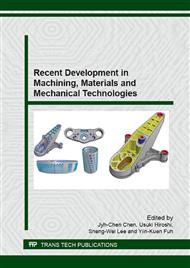p.243
p.251
p.255
p.261
p.266
p.271
p.277
p.283
p.289
Evaluation of Grinding Performance by Mechanical Properties of Super Abrasive Wheel - Evaluation of Grade by Grinding Force
Abstract:
There is the grade as one of the selection criteria of a grinding wheel like WA whetstone or GC whetstone. The grade of grinding wheel is defined as an index which shows the strength of connection of a grain and a grain, and is usually estimated by bending strength. There are many papers about the relationship between the grade of a grinding wheel and the grinding performance. And, the relationship between the grade of a grinding wheel and the grinding performance is almost clear. Also, the relationship between mechanical properties of a grinding wheel and the grade is also clear. On the other hand, since the grain layer of a super abrasive grinding wheel is thin, it is difficult to apply the conventional evaluation test of the grade. And, the evaluation method of the grade which can be adapted the super abrasive grinding wheel is not established. In addition, since the grade of a super abrasive grinding wheel is a manufacture manufacturer's original standard, there is a minute difference by manufacturer. The super abrasive grinding wheel as well as the grinding wheel is conjectured that the grade influences the grinding performance. Namely, it is important to relate the grade and the mechanical properties of a grain layer. However, researches which relate the grade, the grinding performance and the mechanical properties of a super abrasive grinding wheel are not done so far. Therefore, this study examined the relationship between the mechanical properties of a grain layer of a super abrasive grinding wheel and the grade, the grinding performance. The final objective of this study is to evaluate the grinding performance from mechanical properties of a grain layer of a super abrasive grinding wheel. The purpose of this report is to clarify relationship between the grade and the grinding force in a resinoid bond diamond wheel. The specific experiment procedure is as follows. When carrying out surface grinding of the diamond sticks using a grinding wheel, the relationship of the grade and the grinding force was clarified. And based on the knowledge acquired in this experiment, relationship between the grade of a super abrasive grinding wheel and the grinding force was considered. As the results, it confirmed that the grade of a resinoid bond diamond wheel could be evaluated by the grinding force.
Info:
Periodical:
Pages:
266-270
Citation:
Online since:
July 2015
Authors:
Price:
Сopyright:
© 2015 Trans Tech Publications Ltd. All Rights Reserved
Share:
Citation:


